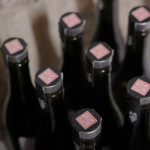PRESENTATION
The Kasu orSakekasu is nothing more than the mothers obtained from the solid residues of rice that occur during the fermentation of sakeand are usually separated at the time of filtration.
It looks like a more or less compact paste, depending on the intensity of the filtration. Its color ranges from pure white at first to a hazelnut in older cases, going through a whole range, from shades of ivory to light brown to the entire range of beiges. It can be eaten fresh and fresh or ripened for several months and sometimes more than a year.
In its composition we find, in addition to the carbohydrates present during the fermentation of sake (starch and sugars), a wide range of amino acids, vitamins, trace elements and most importantly an innumerable variety of bacteria and healthy active components. , which will vary and increase over time, making it a first-class probiotic food that nothing should envy yogurt, kefir, kombutxa, kvass and so many others.
It is highly nutritious and is known to contain up to 12 times more protein and 17 times more fiber than regular rice.
KASU IN GASTRONOMY
In the kitchen it is often used as an additive to give more flavor to certain recipes, as in the case of soups known as kasu-jiru as an ingredient in making marinades called kasu-zuke to increase the humidity in certain stews or to vary the texture and flavor in meat and fish marinades:
- The kasu-jiru is made like a normal dashi broth, based on kombuseaweed and flakes of fermented bonito or katsuobushi to which we will add a little miso, a tablespoon of case per person and finally cook in the soup a few slices of spinach salmon, as well as a few slices of carrot, shitake mushrooms and some peas. Needless to say, this soup has as many variations as there are families in Japan.
- The fish kasu-zuke is made by marinating open and thorny mackerel, salmon or cod fillets or also bream, sea bream, sea bream or pigeon also open and thorny with a mixture of sake, kasu, salt, ground black pepper, sauce soy, grated ginger and occasionally sugar. They are stored in the fridge for one or more days, to taste, and after this time they are lightly cleaned with kitchen paper and can be eaten raw or grilled. It is surprising the radical change in texture and the sweeter taste that the fish acquires.
- In the case of meat, we do the same as with fish and the end result will be that of a matured meat as if we had had a long period of a cold storage, greatly shortening the maturation time.
- Vegetable pickles are usually made of cucumber, eggplant, melon, watermelon, carrot, bamboo shoots, daikon or Japanese turnip or even ginger and are also called shiru-kasu-zukeo or narazukebecause 1,200 years ago it is said that a monk very venerable method of manufacture and was offered to the imperial family of the Nara Period, who had them as a much-appreciated food for what they christened it. Buddhist monks were later sold to samurai, who used them as contingency food in times of war. The technique consists of filling wide-mouthed containers, the barrels are ideal for this purpose, with alternating layers of a mixture of kasu mirin, sugar and salt with others of the vegetables we want to marinate. Some of these pickles can be stored even for years and are known to be especially healthy and legend has it that they are one of the causes of Japanese longevity.
- Another application of the kasu in Japan is the production of a type of amazake, which is consumed with enjoyment in the winter months and is made by mixing and boiling kasu, water, sugar and grated ginger, giving an egg punch drink slightly alcoholic that delights those lucky enough to try it.
OTHER UTILITIES
A separate chapter is the use of sake-kasu as an essential element of alternative therapies and also in the preparation of almost miraculous beauty creams.
MARKETING
As it is a scarce product, as the wineries aim to make and sell sake, it is advisable to collect it when it is available.
SEDA LÍQUIDA offers it to its public in packages of one kilo and 500 grs.



